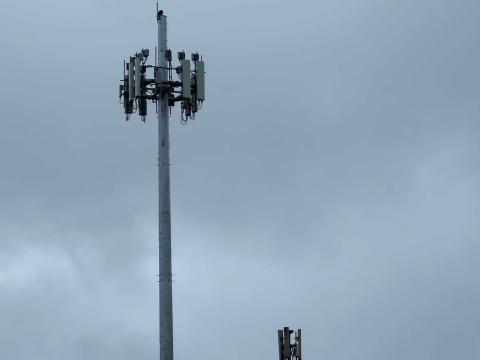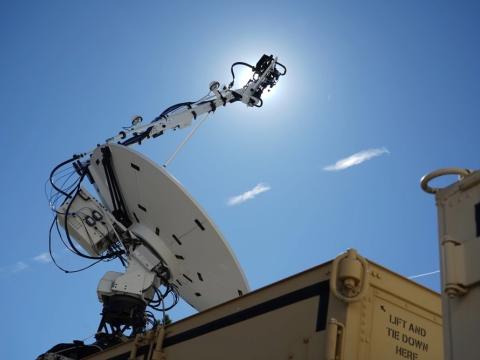Afghanistan Is Only the Tip of the Network-Centric Iceberg
Defense transformation will accelerate the influence of information technology.
Years of designing, testing and deploying information architectures and technologies are paying off in the success of operation Enduring Freedom in Afghanistan. These successes in turn are laying the groundwork for future network-centric capabilities that will bring with them a considerable momentum for change in the U.S. defense infrastructure.
Air platforms and ground forces were thoroughly networked through local communications and with headquarters several thousand miles away. Unmanned aerial vehicles designed for surveillance were equipped with missiles and linked with both ground forces and theater commanders. And, long-range bombers were able to receive new air tasking orders that changed their targeting assignments en route.
Lt. Gen. Joseph K. Kellogg Jr., USA, director, command, control, communications and computers, J-6, the Joint Staff, states that there has been less of a change and more of an evolution in the importance of command, control, communications, computers, intelligence, surveillance and reconnaissance (C4ISR) in interoperability and systems integration. The Afghanistan conflict brought together many new systems in a joint operation—including some that were deployed ahead of schedule—but these efforts did not diverge from the overall approach to developing the digitized battlespace. While their effects may have broken new ground, their incorporation reflected the realization of a steady march to full network-centric warfare.
“What many now are realizing is the importance of what C4ISR and interoperability will do for you. There are a lot of things that had great application and that we knew were good but were unable to pull together for a lot of reasons,” he relates.
Gen. Kellogg distinguishes between the evolutionary nature of these advances and the impact these technologies had on the enemy. The U.S.-led forces entered the fray employing the most advanced technologies seen in warfare. The al Qaida and Taliban adversaries, on the other hand, were several levels of technological capability below the U.S. military. “To those on the receiving end—and to those that are watching us fight the war in Afghanistan—it is not evolutionary. To them it is revolutionary,” he emphasizes.
The evolutionary process is resulting in a better-fused environment and better sensor-to-shooter linkages. It also is leading to a better understanding of the need for a more fused network of interagency homeland defense organizations such as the U.S. Defense Department, the Federal Bureau of Investigation, the Federal Emergency Management Agency and the Central Intelligence Agency.
This evolution has illustrated the importance of information technologies to the future of defense, the general adds. Both Secretary of Defense Donald H. Rumsfeld and Joint Chiefs of Staff (JCS) Chairman Gen. Richard B. Myers, USAF, believe that the use of information technologies will allow future forces to fight faster, cohesively and more efficiently. Their emphasis and focus will lead to a stronger move toward interoperability and jointness of U.S. C4ISR systems, Gen. Kellogg warrants.
This change in focus came about for different reasons, the general continues. First, the new administration produced a leadership change in the Defense Department that, coupled with the new JCS chairman, provided a new perspective on defense posture. Concurrently, experiences gleaned in operation Enduring Freedom changed the focus on how to fight. One reason is by choice, while the other reason is of necessity.
The matter of choice involves the change in leadership. Gen. Kellogg states that Gen. Myers, with his background as commander in chief (CINC) of the U.S. Space Command and JCS vice chairman, understands the clear role of command, control, communications and computers (C4) in the battlespace as well as networked joint interagency C4. Secretary Rumsfeld, just prior to assuming the helm at the Defense Department, headed the Space Commission (SIGNAL, April 2001, page 57), which examined the role of information technology in networked C4ISR.
The element of necessity emerged in Afghanistan, where U.S. forces had to operate in a mountainous, landlocked country the size of Texas that, Gen. Kellogg offers, may have been in an operational sense the toughest environment in which U.S. forces have fought. The long-sought goal of networking weapons platforms with sensor platforms came to fruition in this austere environment where both the need and the advantages became apparent. The U.S. Central Command (CENTCOM) had to employ ground forces in the form of special operations teams that would be tied into forces entering from sea platforms. All these forces needed to be networked with naval and air force platforms to deal with fleeting targets.
“We always knew that you needed a good lash-up between your air platforms and your ground fighters,” Gen. Kellogg allows. “That was brought into clear focus with the special forces teams we had on the ground. [They had a] requirement to network with both naval and air force platforms, be it an F/A-18 or a B-52. We have gone from a linked laboratory environment, where we talk about it, to an actual real environment of combat.”
Networking the sensors and the shooters in real time was only part of the requirement. Many of the weapons platforms needed to be updated on the fly. In the case of B-2 bombers flying from bases in Missouri, this required a capability to change mission tasking while the bombers were en route. Carrier-based aircraft also needed that capability to deal with the dynamic nature of their targets, the general points out. These aircraft were flying the equivalent of a trip from the Gulf of Mexico to St. Louis, and they had to be able to network with the forces on the ground.
As good as these systems proved to be in the Afghanistan operation, the joint environment demonstrated that they can be improved, the general points out. Some improvements already have been implemented, for example, networking the unmanned aerial vehicle (UAV) systems and the AC-130 gunships with ground forces. This real-time capability moved from the conceptual stage to operational status during efforts to target Taliban and al Qaida fighters on the move.
UAVs were used to a greater degree than ever before, Gen. Kellogg continues. The ability to pass information gathered by Predator and Global Hawk back to the combatant commanders enabled near-real- and real-time battlefield situational awareness. The general notes that the CENTCOM commander was able to direct the battle from his headquarters in Tampa, Florida, “at a level that is unprecedented compared to Desert Storm.”
The geographic diversity of the operation’s headquarters presented some challenges for network-centric operations. Gen. Kellogg notes that CENTCOM headquarters in Tampa was successfully networked with a forward headquarters in Kuwait and a subordinate jump headquarters in Uzbekistan. Satellite communications and related technologies enabled this networking capability to a degree not previously achievable, the general relates.
The nature of munitions also changed with this war. U.S. forces achieved new levels of ability to pass information to precision guided munitions. The joint direct attack munition (JDAM), for example, is directed to its target by global positioning system signals. This and other advances spurred by information technology greatly increased the ability to use precision guided munitions.
The Afghanistan operations will validate the importance of networked joint C4 information technologies, Gen. Kellogg declares. These technologies have demonstrated the ability to operate with more speed and clarity than previously achieved.
“We haven’t eliminated the fog of war, and we never will,” he states. “But we can sure reduce the thickness of the fog and enable the ability to see through it.”
Experimentation is a key to this ongoing evolution. “In combat, you cannot accept failure,” Gen. Kellogg declares. “But in experimentation, you can—in fact, you almost have to expect failure and accept it.
“We need to take these wonderful concepts and embed them in experimentation. I believe that Gen. Myers is going to provide a much more focused effort on experimentation and where we are going into the future. Understand that every battlefield is different; every campaign is different; and there will be something out there that someone will come up with that is [a] change,” he warrants.
Gen. Kellogg notes that Gen. Myers’ goal over the next two years, in addition to the global war on terrorism, is to transform the force and strengthen its joint warfighting capability. The key role to be played by C4ISR in this force integration and transformation will have a longer legacy than the near-term advances emerging from the Afghanistan conflict, he maintains. This war has validated the chairman’s vision, and this validation has provided the leverage to move forward with these changes.
Gen. Kellogg predicts that the near-term future will see a change in the role of the Joint Forces Command. This command will be much more focused on its role as a joint experimenter and an agent of change for interoperability. He foresees it becoming more of a functional command than a regional one, and it accordingly will focus more on its role of integrating interoperability.
He adds that Gen. Myers likely will engage all the CINCs in discussions on warfighting, especially involving joint tactical force operations. Input from this dialog will be passed to the Joint Forces Command for inclusion in a robust exercise program. “The agent for change, I believe, will be the Joint Forces Command, with direction and oversight provided by both the secretary of defense and the chairman of the Joint Chiefs of Staff,” Gen. Kellogg states.
This is no “minor tweak in the system,” he continues. “It is a large tweak in the system. When you move from a geographic role—a NATO role as your primary focus—with your secondary role being experimentation, to a single functional role of interoperability and integration, you have a major shift and a major change. This major shift will allow us to fine-tune what we are doing.”
Gen. Kellogg continues that the services are doing a good job on the internal transformation within their respective services. They need to focus on the joint piece of interoperability—command and control—because “that is the winner for us,” he adds. This collaborative element of the transformation still needs work. “The Joint Forces Command will not build you a better aircraft, tank or aircraft carrier—it should not. What it will be focusing on is the inner workings of those systems and the joint interoperability that is command and control,” he emphasizes.
“When it comes to information technologies, we acknowledge the importance of IT in the future; we understand that it will be a key part of the transformation, and we also believe that it will add more and more capability to our joint forces. It is a work in progress. The good news is that we are not starting from a zero baseline. We are continuing to increase, develop and change based on successes in the past.
“Information technology will allow greatly improved clarity of the battlefield; it will give us speed of command and decisive control; and it will give us a networked system of systems so all commanders can decide what they need to execute the mission—more so than they can do today,” the general declares.




Comments